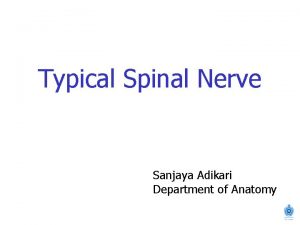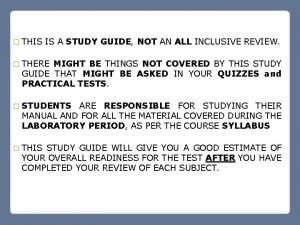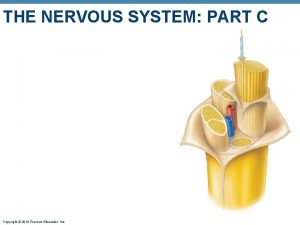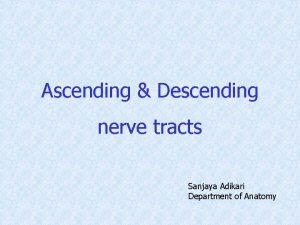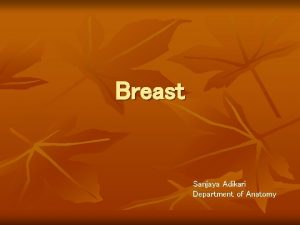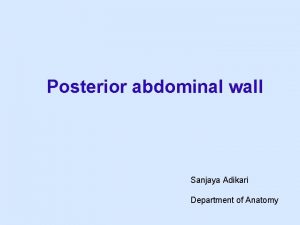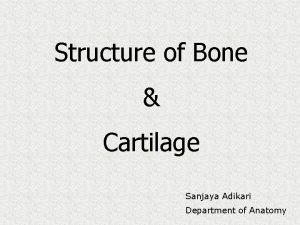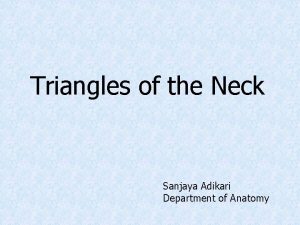Typical Spinal Nerve Sanjaya Adikari Department of Anatomy


















- Slides: 18

Typical Spinal Nerve Sanjaya Adikari Department of Anatomy

• CNS is covered by Skull the skull and the vertebral column • PNS is outside Vertebral column


Structure of a spinal cord segment Posterior median septum Posterior horn Posterior white column Posterior nerve root Lateral white column Lateral horn Central canal Anterior nerve root Anterior horn Anterior white column Anterior median fissure

Dorsal root ganglion Somatic Autonomic


Dorsal and ventral roots • Dorsal roots contain afferent (sensory) axons • Ventral roots contain efferent (motor) axons • The ventral roots continue out from the spinal cord, and mix with their corresponding dorsal nerve root at a point after the ganglion • The combined dorsal and ventral roots are called a spinal nerve (therefore, spinal nerves are mixed).

Spinal nerve is mixed (motor + sensory + autonomic)

Spinal nerve is mixed (motor + sensory + autonomic) • Spinal nerve refers to the mixed spinal nerve • It is formed from the dorsal and ventral roots • Passes out through the intervertebral foramen • There are 31 bilaterally-paired spinal nerves – 8 cervical nerves (C 1 -C 8) – 12 thoracic nerves (T 1 -T 12) – 5 lumbar nerves (L 1 -L 5) – 5 sacral nerves (S 1 -S 5) – 1 coccygeal nerve (Co)

Spinal cord Vertebral column 7 8 12 12 5 5 1

Spinal nerves C 1 C 1 C 2 C 3 C 4 C 5 C 7 C 8 T 1 T 2 C 6 C 7 C 8 T 1 T 3 T 2 T 3 T 4 T 5 T 6 T 7 T 10 T 8 T 9 T 10 L 1, L 2 T 11 L 3, L 4 T 12 L 5 L 1 S, C

Anterior and posterior primary rami • The posterior primary rami have lateral and medial branches They supply – back muscles and skin over the back • The anterior primary rami give off anterior and lateral cutaneous branches They supply – the rest of the body wall • Anterior primary rami also give rise to the roots of the various nervous plexuses

Spinal nerves in the thoracic region These are typical spinal nerves Posterior Lateral cutaneous branch Anterior Medial Lateral


Rami communicantes • Gray ramus communicans unmyelinated • White ramus communicans myelinated


Nerve plexus Formed by communicating branches between anterior primary rami of spinal nerves. Anterior primary rami form the roots of nerve plexus What are the advantages of a nerve plexus? Last’s Anatomy, 10 th ed. Page 13

Dermatome Area of skin supplied by a single spinal nerve or spinal cord segment Myotome The muscle/s supplied by a single spinal nerve or spinal cord segment
 Posterior arch vein
Posterior arch vein Sanjaya adikari
Sanjaya adikari Spinal cord nerve anatomy
Spinal cord nerve anatomy Art-labeling activity figure 13.6a (1 of 2)
Art-labeling activity figure 13.6a (1 of 2) Spine meninges
Spine meninges Median nerve innervates
Median nerve innervates Inferior gluteal nerve
Inferior gluteal nerve Partition at the inlet of thorax
Partition at the inlet of thorax Posterior median septum
Posterior median septum Spinal nerves names
Spinal nerves names Typical cell
Typical cell 31 pairs of spinal nerves
31 pairs of spinal nerves The spinal cord anatomy
The spinal cord anatomy Spinal cord anatomy
Spinal cord anatomy Spinal cord diagram
Spinal cord diagram Spinal cord anatomy
Spinal cord anatomy Parts of a reflex arc
Parts of a reflex arc Spinal angiogram
Spinal angiogram Dr ayling
Dr ayling








